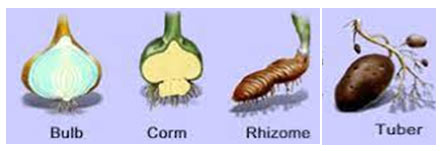Comparison # 1
| Rhizome | Corm |
| The elongated thick and fleshy underground stem is called rhizome. | The thick, solid, rounded, condensed underground stem is called the corm. |
| It has distinct nodes and internodes. | It has much-reduced nodes and internodes. |
| It is formed only in a single generation. | It may form three or more generations. |
| Ginger is an excellent example of the rhizome. | Colocasia is an example of the corm. |
Comparison # 2
| Rhizome | Tuber |
| The elongated thick and fleshy underground stem is called a rhizome. | The swollen underground tips of branches of the vertical axis which store food and use for vegetative propagation is called stem tuber. |
| It does not have foliage leaves. | Tuber develops foliage leaves. |
| Stored food is present inside the rhizome. | Food is stored up in the tips of underground branches to form tubers. |
| Buds are present in the axil of scale leaves. | These are groups of lateral buds in scale leaves and are called eyes. |
| Eyes are absent. | Eyes are present. |
| An example is Ginger. | An example is potatoes. |
Comparison # 3
| Corm | Bulb |
| The thick, solid, rounded, condensed underground stem with few internodes is called the corm. | A specialized much reduced short underground stem composed of the broad conical disc is called a bulb. |
| They do not have fleshy leaves. | Large fleshy leaves are borne on the upper surface of the bulb. |
| Stored food is present. | Stored food is present in bulbs. |
| Buds are present in them. | They have apical and axillary buds on their upper surface. |
| Colocasia is an example of the corm. | Onion, garlic, etc. are examples of bulbs. |

